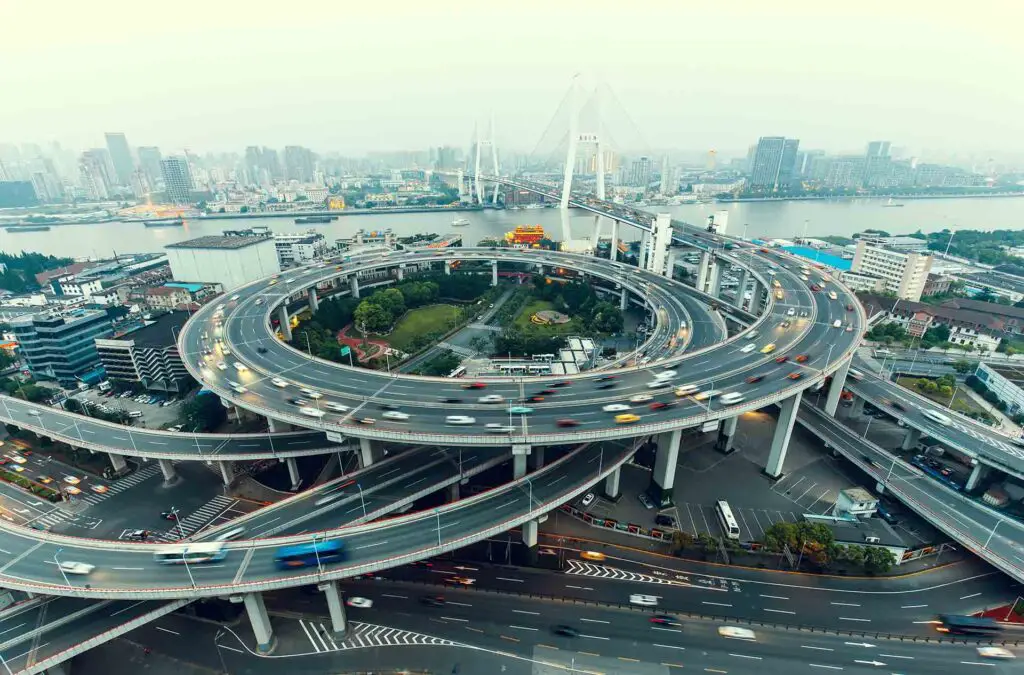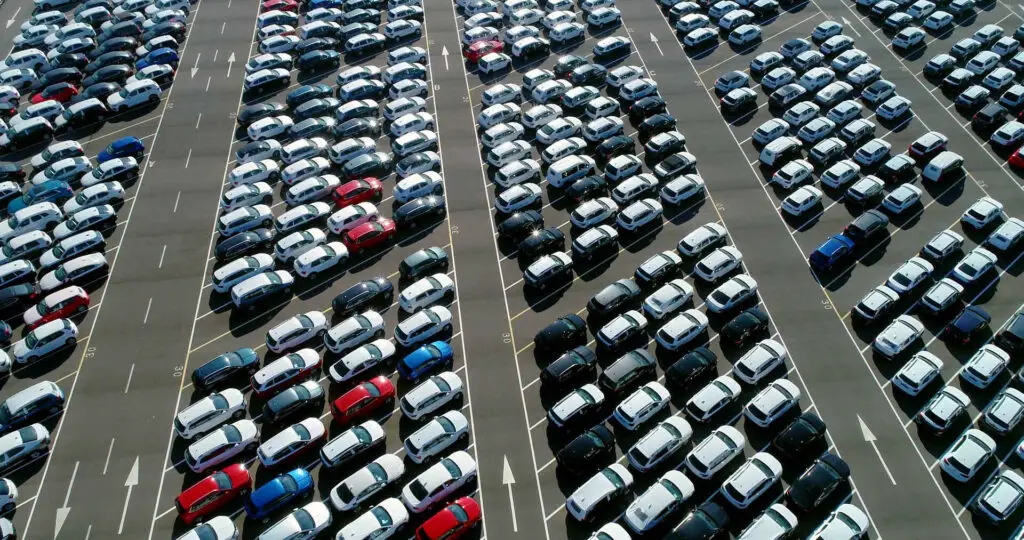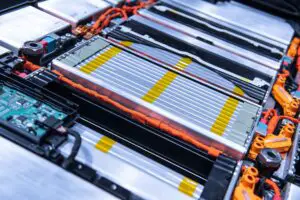Ever found yourself on a highway so wide you wondered if you accidentally took a detour onto a runway? Well, you haven’t seen anything like this before – the Katy Freeway, the widest highway in the US. In Texas, where everything is already bigger, it seems like the notion of “too much space” doesn’t exist. This colossal roadway is a testament to our love affair with cars, space, and the open road. Let’s dive into the vastness of America’s grand asphalt ocean – it will be a wild ride.
What Is the Widest Highway in the US?
Tucked deep in the heart of Texas lies a marvel of modern transportation – the Katy Freeway. But where is the widest highway in the US exactly? Well, it stretches through Houston as the widest part of Interstate 10.
With its sprawling lanes inviting travelers and commuters alike, the Katy Freeway offers a glimpse into the boundless possibilities of road design. Such engineering marvel embodies the spirit of exploration and vastness that perfectly defines the American road trip experience through famous routes and sights.
Record-Breaking Dimensions – Is It the Biggest Highway in the World?
The Katy Freeway boasts up to 13 lanes in its widest sections. It also includes additional feeder roads and High Occupancy Vehicle (HOV) lanes, intricately woven into its design. The former runs parallel to the main lanes, offering access to local streets and businesses, while the former promotes carpooling, reducing traffic and environmental impact.
Yet, when we cast our gaze globally, Houston’s claim to the world’s widest highway dims. The true holder of this title is the G4 Beijing-Hong Kong-Macau Expressway, which, during peak congestion, expanded to an astounding 50 lanes. Closer to home, Canada boasts a wider freeway as well – Ontario Highway 401, also known as the King’s Highway 401.

From Conception to Expansion – A Glimpse Into the History of the Katy Freeway
Katy Freeway’s story is a riveting tale of ambition, growth, and adaptation, mirroring the dynamic spirit of Houston itself. Originally carved out of the Texas landscape to facilitate movement and economic growth, this portion of Interstate 10 began its journey in the 1960s, setting the stage for what would become an iconic testament to infrastructural evolution.
As Houston burgeoned, swelling with new residents and industries, the Katy Freeway became the lifeline of city driving. The biggest Katy Freeway expansion started in the early 2000s and was completed by 2008, reshaping not only the freeway but also redefining what it means to travel, work, and live in the vast, vibrant expanse of Texas.

Highway Engineering Challenges – It’s Not Easy to Get This Big
Imagine embarking on a project to transform one of the busiest highways into the nation’s widest. The vision for the Katy Freeway’s expansion was certainly bold and ambitious. Yet, the path to achieving this grand scale was fraught with hurdles, each demanding innovative solutions and unwavering determination.
Here are some of the critical challenges faced and how they were ingeniously solved:
- Land acquisition – securing enough land for the expansion required meticulous negotiation and planning, which involved careful coordination with local governments and property owners,
- Environmental concerns – the environmental impact of road widening was balanced out by implementing green spaces around the freeway, using environmentally friendly materials, and designing drainage systems that protect local ecosystems,
- Maintaining traffic flow – ensuring that the freeway remained operational during expansion was solved with temporary lanes,
- Engineering over waterways – the freeway’s path crosses several waterways, requiring innovative engineering to construct bridges and overpasses that are both functional and safe,
- Integrating public transport options – accommodating public transport within the freeway’s design was crucial, so dedicated HOV lanes and improved access points for buses and shuttles were integrated.
Innovative Solutions for Traffic Management Had to Be Made
The Katy Freeway’s transformation is a testament to human ingenuity in the face of complex challenges. Heavy traffic congestion solutions had to be made, and this was done by combining cutting-edge technology and thoughtful design.
The freeway incorporates intelligent transportation systems, including real-time traffic monitoring, to adjust signal timings and manage congestion efficiently. Additionally, the already-mentioned inclusion of continuous feeder roads and multiple HOV lanes ensures smooth transitions between high-speed and local traffic.
What’s the Impact of the Katy Freeway and Its Urban Infrastructure Development on Houston?
When you build something as colossal as the Katy Freeway, you’re not just laying down asphalt – you’re reshaping the landscape of a bustling metropolis like Houston. It’s like inviting a giant to stride through the city – everything around it inevitably feels the impact. So, let’s hop in our metaphorical cars and take a joyride through the effects this titan of transportation has had on its urban surroundings:
Traffic Flow and Congestion
One might think that with more lanes than a bowling alley, the Katy Freeway would be a smooth sail, free of traffic jams. However, the story is a bit more nuanced. Initially, the expansion brought sighs of relief to commuters, significantly improving travel times. But the extra space soon attracted more drivers, filling up those lanes as quickly as they were built. This phenomenon reflects the complex dance between infrastructure and traffic flow, where more roads often invite more traffic.
Economic and Environmental Considerations
The Katy Freeway’s expansion wasn’t just a matter of adding lanes – it was a significant economic boost for Houston. By improving accessibility, the freeway has spurred development along its vast corridors, from commercial centers to residential areas, contributing to Houston’s economic growth.
However, this silver lining comes with a cloud – the environmental impact. Even though sustainable transportation planning was implemented, the expansion has raised concerns about increased air pollution and the carbon footprint associated with higher vehicle volumes. It’s a classic case of environmental give-and-take, where the benefits of economic growth and improved infrastructure weigh against the quest for sustainability.
Urban Development and Public Response
The Katy Freeway has acted like a giant rolling pin, flattening the dough of Houston’s urban landscape into a new shape. This reshaping has had mixed reviews from the public. On one hand, improved infrastructure has led to enhanced connectivity, making it easier for residents to access different parts of the city.
On the other, it has sparked debates about urban sprawl and the reliance on personal vehicles over public transportation. The Katy Freeway, in its vastness, encapsulates the challenges and opportunities of modern urban infrastructure, making it a case study in balancing progress with preservation.
What We’ve Learned So Far From This Marvel of Urban Highway Design
The Katy Freeway stands as a monumental lesson in urban highway design, offering a wealth of insights into the complexities of modern infrastructure development. From its ambitious expansion to its sophisticated traffic management solutions, this freeway embodies the pinnacle of engineering innovation.
That way, it serves as a vivid illustration of how infrastructure can simultaneously drive economic growth, influence urban development, and pose environmental challenges. The freeway’s story teaches us the importance of forward-thinking and adaptive strategies in urban planning, emphasizing the need to balance expansion with sustainability.
It’s Important We Take These Insights Forward Into Future Urban Projects
Armed with the lessons gleaned from the Katy Freeway, the path forward for future urban projects becomes clearer. It underscores the necessity of integrating sustainability and environmental stewardship into the heart of urban planning. After all, it’s not enough for us to just drive electric vehicles – our roads need to be more eco-friendly, too.
Future endeavors must prioritize not just the expansion of physical space but also the enhancement of life quality, environmental health, and economic vitality. Adopting a holistic approach that considers long-term impacts, encourages the use of alternative transportation, and fosters community engagement will be crucial.

Riding Wide – A Lighthearted Spin Down the Katy Freeway’s Lane of Fame
As we coast to the end of our journey along the wide, wild expanse of the Katy Freeway, it’s clear this isn’t just a story about a stretch of road in Texas. It’s a narrative about ambition, innovation, and the endless quest to connect spaces and people in the most efficient, albeit massive, ways possible. So, the next time you’re out on the road, remember this marvel of engineering and what it means to us as a whole, but make sure to keep your eyes on the road ahead!
Frequently Asked Questions
Why Was the Katy Freeway Expanded to Become the Widest in the US?
The Katy Freeway was expanded to address the growing traffic demands of the Houston area, aiming to improve traffic flow and reduce congestion. As one of the busiest regions in Texas, the need for a larger infrastructure became apparent to accommodate the increasing number of vehicles. The expansion was part of a broader initiative to enhance transportation efficiency and safety in the rapidly expanding city.
How Many Lanes Does the Widest Section of the Katy Freeway Have?
The widest section of the Katy Freeway boasts up to 13 lanes, including main lanes, feeder lanes, and High Occupancy Vehicle (HOV) lanes. This section is designed to accommodate a vast amount of traffic, making it the widest in the United States by far.
What Were the Major Challenges in Expanding the Katy Freeway?
Expanding the Katy Freeway posed several significant challenges, including land acquisition, environmental concerns, and maintaining traffic flow during construction. Engineering challenges also arose, such as constructing over waterways and integrating technology for traffic management.
Has the Expansion of the Katy Freeway Succeeded in Reducing Traffic Congestion?
While the expansion of the Katy Freeway initially reduced traffic congestion, the long-term effects have been mixed due to induced demand. This phenomenon occurs when increased roadway capacity leads to more people choosing to drive, eventually restoring the congestion levels. Thus, while there have been improvements in traffic flow, the freeway still faces congestion challenges during peak hours.
What Are the Environmental Impacts of Such a Large Highway Expansion Project?
The environmental impacts of the Katy Freeway expansion include increased air pollution and potential disruption to local ecosystems due to the extensive construction. The project also contributes to urban sprawl by encouraging further development and reliance on personal vehicles, which can have long-term effects on the region’s air quality and greenhouse gas emissions. Efforts to mitigate these impacts have included integrating green spaces and promoting HOV lanes to reduce single-occupancy vehicle use.








